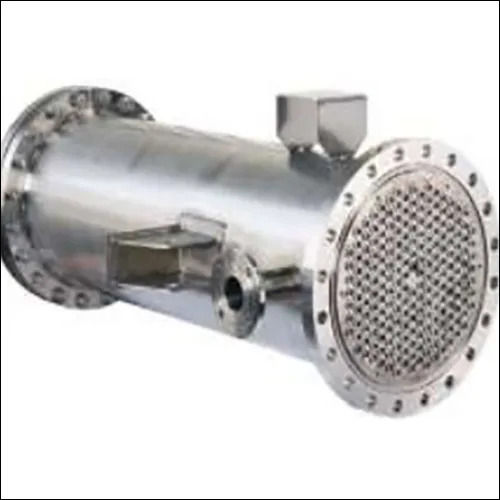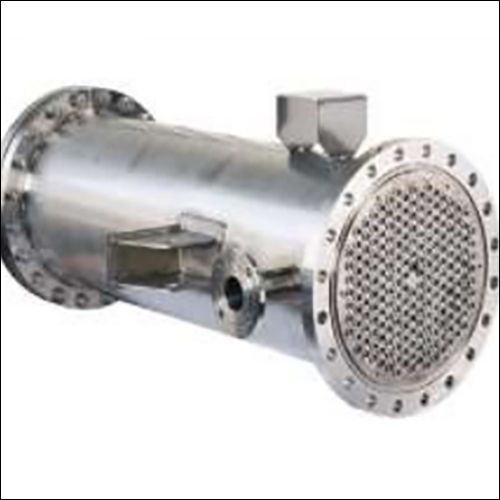Shell and Tube Heat Exchanger
50000 INR/Unit
Product Details:
- Temperature High-temperature Celsius (oC)
- Condition New
- Usage Industrial
- Structure tube Heat Exchanger
- Size Different Available
- Product Type Tube Heat Exchanger
- Color Silver
- Click to View more
X
Shell and Tube Heat Exchanger Price And Quantity
- 50000 INR/Unit
- 1 Unit
Shell and Tube Heat Exchanger Product Specifications
- High-temperature Celsius (oC)
- Silver
- New
- Tube Heat Exchanger
- Industrial
- Different Available
- tube Heat Exchanger
Shell and Tube Heat Exchanger Trade Information
- Vadodara
- Cash Advance (CA), Cash in Advance (CID), Cheque
- 100 Unit Per Month
- 7 Days
- Standard Packaging
- Asia, Australia, Central America, North America, South America, Eastern Europe, Western Europe, Middle East, Africa
- All India
Product Description
A shell and tube heat exchanger is a type of heat exchanger used in various industries for heat transfer between two fluids. It consists of a set of tubes, one fluid flowing through the tubes and the other fluid flowing around the tubes within a larger shell. These heat exchangers are commonly used in applications where large amounts of heat need to be transferred efficiently, such as in power plants, chemical processing, oil refineries, and HVAC systems.
Main Components of a Shell and Tube Heat Exchanger:
-
Shell:
- The outer casing of the heat exchanger that contains the bundle of tubes.
- It holds one of the fluids and directs it around the tube bundle for heat exchange. The shell can be designed in various configurations, such as single-pass, multi-pass, or U-tube designs, depending on the flow and heat transfer requirements.
-
Tubes:
- A bundle of tubes inside the shell through which the other fluid flows. These tubes are typically made from materials like stainless steel, copper, carbon steel, or titanium depending on the specific requirements, such as corrosion resistance, thermal conductivity, and pressure rating.
- Fluid Flow: One fluid flows through the tubes (the tube-side fluid), while the other fluid flows over the tubes in the shell (the shell-side fluid).
- Tubesheets: The tubes are held in place by tubesheets (metal plates with holes) at both ends, which support the tubes and direct the fluids into or out of the system.
-
Tubesheets:
- These are the plates that hold the tubes in place and seal the tube ends. The tubesheets provide the necessary support and separation for the fluids entering and exiting the tube side and shell side of the heat exchanger.
-
Baffles:
- Baffles are plates inside the shell that direct the shell-side fluid over the tubes, promoting turbulence and increasing heat transfer efficiency. Baffles also help support the tubes and prevent them from vibrating, which could lead to tube damage.
- Baffles control the flow path of the shell-side fluid to ensure that it makes sufficient contact with the tubes for effective heat transfer.
-
Inlet and Outlet Nozzles:
- Nozzles are used for the inlet and outlet of both the shell-side and tube-side fluids. They allow the fluids to enter and exit the heat exchanger and are usually located at opposite ends of the shell.
-
End Caps or Heads:
- The ends of the shell are capped with end caps (also known as heads) that close the shell and support the tubesheets. There are generally two types of heads: fixed head and floating head.
- In a floating head design, the tubesheets are allowed to move slightly, which helps to accommodate thermal expansion and contraction of the tubes.
-
Support Plates (optional):
- Support plates may be used to secure the tube bundle inside the shell. These plates are used to reduce vibration and movement, which could cause damage to the tubes.
-
Expansion Bellows (optional):
- In some cases, expansion bellows are included in the design to accommodate thermal expansion in the shell or tubes, preventing mechanical stress or failure due to temperature fluctuations.
Efficient Heat Transfer for Industrial Applications
Our Shell and Tube Heat Exchanger is built to deliver exceptional performance in high-temperature environments, tailored for diverse industrial needs with its robust construction.
High-Performance Exchanger with Versatile Uses
Designed with precision, it combines durability and adaptability, making it ideal for optimal heat exchange operations across industries.
FAQs of Shell and Tube Heat Exchanger:
Q: How does a Shell and Tube Heat Exchanger function?
A: It works by transferring heat between fluids through tubes enclosed within a shell, maximizing thermal efficiency with high-temperature handling capability.Q: What industries benefit from Shell and Tube Heat Exchangers?
A: They are vital in industries like chemical processing, oil refining, power generation, and food processing requiring robust thermal management solutions.Q: When should one consider using a Shell and Tube Heat Exchanger?
A: It is suitable when high thermal efficiency is required in processes that involve strictly managing temperatures and large-scale fluid interactions.Q: Where can you source Shell and Tube Heat Exchangers in India?
A: They are distributed by dealers, manufacturers, and suppliers across India, ensuring availability for various needs.Q: What is the process of heat exchange in this equipment?
A: The shell contains a tube bundle where fluids flow, utilizing conductive materials to exchange heat efficiently between hot and cold streams.Q: Why is this heat exchanger ideal for high-temperature applications?
A: Its design accommodates efficient heat transfer, handling elevated thermal conditions without compromising performance.Q: What advantages do Shell and Tube Heat Exchangers offer to businesses?
A: They ensure efficient energy use, reduce operational costs, and enhance the reliability of industrial thermal processes.Tell us about your requirement

Price:
Quantity
Select Unit
- 50
- 100
- 200
- 250
- 500
- 1000+
Additional detail
Mobile number
Email
Other Products in 'Heat Exchanger' category
 |
PRIME ADVANCE POLISHING SYSTEM PVT. LTD.
All Rights Reserved.(Terms of Use) Developed and Managed by Infocom Network Private Limited. |




